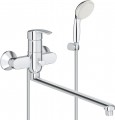Shape
—
Straight. Spout that have straight or almost straight shape and directed almost horizontally (other arrangements are highlighted in a separate paragraph — see “At right angle”). Generally, such a spout combines simplicity, practicality, and versatility. In particular, it can be of any length, and can also be rotary (see “Spout”), while being inexpensive to manufacture. Nowadays, straight spouts are extremely popular, and in almost all types of taps (see “Suitable for”). The exception is perhaps the kitchen application: this form is inconvenient for washing dishes by itself and leaves less space for dishes in the sink than other shapes (for example, angled or gooseneck spouts).
—
Gooseneck. Taps with a spout in the shape of an arc, usually semicircular and rather steep. This design is most popular in kitchen taps, as it provides the necessary space for washing large dishes. Many models with such a spout are designed for washbasins — they also use a vertical installation, for which the arc is very convenient. And gooseneck bath taps are most often original premium models installed directly on the side of the bath (also horizontally).
—
L-shaped. Spout in the shape of the letter “L” — with a vertical base and a horizontal “crossbar” extending from it. Thanks to this shape, the spout can be positioned at a sufficiently high height, which is especially conveni
...ent when used in the kitchen or with a washbasin. Most of the L-shaped models refer to these specialization options (see “Suitable for”). According to the type of the tap (see the corresponding list), they are usually single-lever, while the joystick is located on the side; however, there are other options — both in the location of the joystick, and in the type of control.
— U-shaped. Spouts of this category resemble L-shaped models (see the relevant paragraph), in which the end of the spout is noticeably bent downwards. This gives them an original shape, as well as some resemblance to gooseneck models. U-shaped spouts are typically taller and are intended for use in kitchens or washbasins. At the same time, they are not as popular as the mentioned L-shaped ones, and even more so the gooseneck ones. In particular, because of the higher cost with no obvious practical advantages (although this form may well be optimal in terms of design).
— S-shaped. A variant that is predominantly found in bath models (including bath and washbasin solutions) as well as in some kitchen taps. The spout in this arrangement has the shape of the letter “S”, laid “on its side”. This design is well suited for wall-mounted models, where the spout outlet must be placed noticeably below the tap itself.
— At right angle. A straight spout located at a right angle relative to the tap body — directed from the base of the body up or down. This shape is especially suitable for washbasins and kitchens, and it is mainly found in taps of those specializations (see “Suitable for”). Most models with a similar spout have a fairly modern appearance, thanks to that they fit well into modern, high-tech interiors, etc.
— Curved at an angle. A spout that leans upward from the base of the tap and curves slightly downward at the end. The shape is in many ways reminiscent of the “at right angle” option, but it has its own characteristics. Firstly, such a spout can be made somewhat longer, which is convenient for kitchen use: the outlet is at a sufficiently high height and there is enough space under it to wash even large dishes without any problems. Most of the models in this category are just made for the kitchen. Secondly, for some users, this form is preferable from an aesthetic point of view (although, of course, this is a matter of personal taste). These spouts look more “cheap” compared to the products of the “at right angle” form factor and are extremely rare among top plumbing brands.
— Vertical jet. This type of spout is found among bidet taps. It involves vertical spraying of a water jet for taking a hygienic shower after visiting the toilet. The mortise vertical spray module is installed separately from the tap. Usually, the design also assumes a water return valve.
— Connected to overflow. Taps with a spout in the form of a flexible hose that connects to the overflow of the bathtub, and the water is poured through it. Thanks to such taps, minimalism is ensured in the appearance of the bathtub, which is caused by the absence of a classic spout. In addition, there is no need to make extra holes in the side of the bathtub to install the tap.Cartridge diameter
The diameter of the cartridge used in the tap.
The cartridge is called the "heart" of the tap — the part directly responsible for adjusting the pressure and/or temperature of the water (in some models — also for switching between spout and shower). The main dimension of this part is precisely the diameter. However, in fact, this size becomes relevant only if it is necessary to replace the cartridge. But when choosing a tap, it does not really matter — from the point of view of characteristics, only the overall dimensions of the device depend on the diameter of the cartridge, and then quite approximately and without a fundamental difference between individual models.
Water flow
The maximum water flow during the operation of the tap, in other words, the maximum amount of water that it can pass through in a minute. This characteristic is important, foremost, for models designed for baths (see "Suitable for"): the greater the throughput, the faster the bath will fill. However, the meaning of this paragraph is not limited to this. First, flow information can be useful in certain calculations related to water supply — for example, to calculate the required pump capacity. Secondly, high-end taps can be equipped with aerators to achieve a powerful and efficient jet with low water consumption; the consumption indicated in the characteristics allows you to evaluate the efficiency of such devices in comparison with analogues.
Hose length
The length of the hose provided in the design of the tap. This is a secondary parameter, since the hose is selected by the manufacturer in such a way that it is comfortable to use it for its main purpose — for taking a shower. But for tall people, the standard length may not be enough, so it is appropriate to know its dimensions for greater comfort and ease of use.
Diverter
A diverter is a device that switches a water flow between spout and shower head. The design of such a device and the way it is controlled can be different, in modern taps you can mainly find the following options:
— Button. Diverters of this type have the form of a button; but its design depends on the characteristics of a particular tap. In relatively simple mechanical models (most of them), the button is also made mechanical, and to switch from spout to shower, you need to pull it up. And switching in the opposite direction — from a shower to a spout — can often be carried out not only manually, but also automatically, when the water is turned off (see "Features — Shower / bath auto switch"). In some taps, auto-switching can also be blocked by the user (usually by turning the button in the up position).
In turn, in advanced electronic devices, such a diverter is made in the form of an electric button that closes the contacts that control the valve.
— Lever. Diverter in the form of a rotary lever. Most often, this lever directly controls the valve that switches the flow of water. This design is considered somewhat less reliable than push-button, but it is much simpler and cheaper, which makes it very popular — especially in relatively inexpensive taps. But in premium devices, this type of diverter can operate according to other, more advanced principles — for example, a lever can work as an electronic switch.
— Turning the spout. A r...ather rare and specific option: the role of the lever that controls the flow of water is performed directly by the spout, to the base of which a shower hose is connected. Such a control, usually, works as follows: while the spout is perpendicular to the tap body, water flows through it, and to switch to the shower, the spout turns, being under the tap. Such devices look interesting, and are convenient to use. On the other hand, they are quite complex and expensive, and the spout itself, for a number of reasons, is typically made quite short. Therefore, this variant has not gained popularity.
— Removable. A diverter located outside the body — usually between the tap itself and the spout. Typically, on one side of such a device there is a control element (most often a small lever or a rotary tap), and on the other, a pipe for connecting a shower hose. And the name "removable" suggests that this part can be easily removed if needed — unlike, for example, push-button or lever solutions, which are usually built directly into the tap body and are very difficult to dismantle or replace. Accordingly, after removal, the diverter can either be replaced with another one, or removed altogether by connecting the spout directly to the tap. This is the main advantage of this option: in case of malfunctions in the diverter, it can be removed without any problems for repair or replacement, while the tap (with the exception of the “shower part”) remains fully operational.
Inlet communication
The type of water pipes the tap is designed for.
— Hoses. With a flexible connection type, polymer tubes (hoses) are used to connect the tap to the water supply, which can bend well and are reinforced with a metal mesh for strength. This ensures ease and versatility of attachment — thanks to the flexibility of the pipe, it can be carried even in cramped places. On the other hand, such a supply is less durable and reliable than a rigid one. It is mainly used in models for kitchens and sinks (see "Suitable for"). Installation pipes may be included in the package of the tap; this point should be clarified separately.
— Rigid pipes. Such taps are designed for installing directly to metal water pipes. The advantage of this type is reliability and strength, the disadvantage is significant restrictions on the installation site: you either have to put the tap where the pipes were made during construction, or redo the communications, which is associated with great inconvenience and cost. On the other hand, such taps are usually used for bathtubs and showers, and in modern bathrooms, typically there are no problems with unsuccessful installation of pipes.

